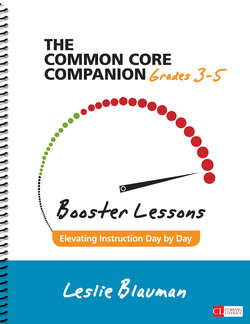Читать книгу The Common Core Companion: Booster Lessons, Grades 3-5 - Leslie Blauman - Страница 84
На сайте Литреса книга снята с продажи.
ОглавлениеLesson Sequence 2 Integrating Reading Craft and Structure With Opinion Writing
In this lesson sequence, students examine arguments and write an opinion piece of their own. To craft strong pieces, students need to read a variety of opinions and discern how writers declare their idea and then develop and organize their supporting ideas and evidence. I feature fifth-grade lessons that mesh history content with literacy; however, it is easily adapted to third and fourth grades (see pages 74–77) and across the curriculum and with any topic that lends itself to students voicing rich, authentic, and informed opinions.
This sequence can be used any time of the year and across the instructional day. It builds on Sequence 1 on point of view, where persuasive or opinion writing is introduced. That sequence used literature as a focus; in this sequence it’s informational text. Here, we hone in on students’ knowledge of opinion and persuasion to go more deeply into argument. It focuses on the Revolutionary War but works with any social studies or science topic, thus the mesh with disciplinary literacy. Ideally, provide your students with direct instruction on text features and annotating in informational text beforehand. It works nicely with textbooks as the reading material, but be sure students understand how the textbook is organized and how to read it in order to make this sequence productive. While textbooks are the norm in many schools and districts, bringing in a variety of texts, visuals, videos, and documents makes disciplinary literacy more engaging, leading to deeper understanding and thinking.
Task
If you had lived in America around 1775, would you have been a Loyalist or a Patriot—and why? Take a stand. State your opinion and support it with three or more reasons with facts and details.
This sequence can be replicated throughout the year with different content or curriculum focuses. Use it any time you want to build students’ background knowledge about a topic in advance of writing about the content they learned. It can also be “flipped” to use with literature. As you read through the booster lessons and unit plans, jot notes of how you might tweak it to fit other standards. If you want, build out a unit of study on evaluating arguments and claims and writing opinion pieces. Units work best when they are oriented on an essential question (e.g., How do events affect history? Why are tropical rain forests worth preserving? Is technology making youth less social?). Visit www.corwin.com/thecommoncorecompanion to see unit plans.
Core Connections
Focus Writing Standard 1
Writing Standards 4, 5, 6, 8, 9, and 10
Reading Standards 1, 6, 8, 9, and 10
Speaking and Listening Standards 2, 3, 4, and 6
Language Standards
What Teachers Guide Across the Week
What Students Do Across the Week
Students in the intermediate grades need lots of exposure to exemplary opinion essays, editorials, speeches—and class discussion that teases apart how the writer accomplished it. Opinion and persuasion, in just about every aspect of our lives, sways us today, and they helped shape (and continue to shape) the world and essentially the country in which we live. Well-written opinions can change our thinking. And if students are truly thinking, they need to recognize the opinion or bias or propaganda in what they read, view, or hear. They need to become critical
